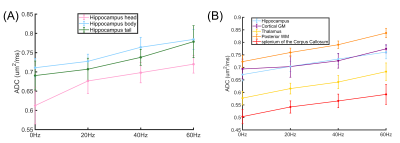Haotian Li1, Yi-Cheng Hsu2, Tao Zu1, Zhiyong Zhao1, Ruibin Liu1, Yi Sun2, Yi Zhang1, and Dan Wu1
1Key Laboratory for Biomedical Engineering of Ministry of Education, Department of Biomedical Engineering, College of Biomedical Engineering & Instrument Science, Zhejiang University, Hangzhou, China, 2MR Collaboration, Siemens Healthcare China, Shanghai, China
1Key Laboratory for Biomedical Engineering of Ministry of Education, Department of Biomedical Engineering, College of Biomedical Engineering & Instrument Science, Zhejiang University, Hangzhou, China, 2MR Collaboration, Siemens Healthcare China, Shanghai, China
An
inversion-recovery prepared oscillating gradient diffusion sequence with 3D
GRASE acquisition and GRAPPA acceleration was developed. The IR module
corrected the CSF effect on diffusion-time dependency measurements in the human brain.

Figure
4: Mean
ADC values from the 3D IR-OGprep-GRASE sequence measured in several GM and WM
regions at different frequencies (60Hz, 40Hz, 20Hz, and 0Hz). (A) ADCs in the hippocampal head were lower than that in the
hippocampal body or tail, and its td–dependent change was faster (from PG to OG-20Hz) than the other two
parts. (B) The td–dependency of cortical GM was distinct compared to other GM and WM
regions, with a slower td–dependent change from PG to OG-20Hz.The error bar represents the standard deviation.

Figure
3: Diffusion-time
(td) dependent ADC
measured using the 3D IR-OGprep-GRASE and OGprep-GRASE
sequences at different frequencies (60Hz, 40Hz, 20Hz,
0Hz). For the 3D IR-OGprep-GRASE sequence,
all ROIs showed td-dependent
changes of ADC. In comparison, for the 3D OGprep-GRASE sequence without IR
module, the td-dependent
effect was not observable for regions close to the ventricle and sulci, including
the hippocampus, cortical gray matter, and splenium of corpus callosum. (*p < .05 and **p < .01 by post-hoc t-test)
